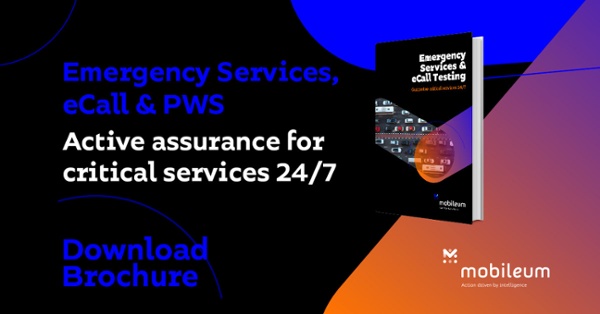On November 11, 2021, both fire and police emergency numbers completely failed in major cities in Germany, including Berlin, Hamburg, and Frankfurt, with callers unable to reach emergency operators for urgent assistance between about 4:30 am and 5:40 am local time. During this over one-hour period, people wishing to make emergency calls were advised to call local police stations directly. An event that affected everyday occurrences, but, fortunately, with no reported large-scale incident. Nevertheless, during an emergency, every second counts.
Although we cannot prevent emergency circumstances from happening, access to and availability of emergency numbers, as well as proper routing, are unquestionably critical. Emergency numbers are a vital part of a nation’s emergency response and disaster preparedness system. Failing to ensure that stakeholders always provide uninterrupted, reliable, and resilient communications access to the Public Service Answering Point (PSAP) or misrouting or providing false location information frequently result in deadly or life-threatening delays that should and could have been avoided under normal conditions. Regulatory bodies typically mandate periodic testing of localization services for emergency calls. Evidently, noncompliance with regulations can result in legal actions and sanctions against operators. As an example, four US operators have agreed to pay combined $6 million to settle investigations into their respective compliance with the FCC’s emergency call reliability rules during network outages in September 2020.
Testing and monitoring tools for emergency services must be implemented to ensure response availability and reliability, regardless of the scale, scope, and complexity of an incident. Responsiveness is a key criterion and the initial point of preparedness and ability of any emergency service system to perform effectively. It should be noted that even if there is no SIM, emergency calls and eCalls must go through and be routed to the nearest PSAP.
Effective testing and monitoring tools must enable carriers and public safety entities to ensure that standard emergency calls, i.e., the country’s easy-to-remember numbers, are infallibly accessed when police, fire and medical services are requested. Furthermore, they must guarantee that the telephone number and location of emergency calls made from both wireline and wireless phones, a capability called Enhanced Emergency Numbers, are automatically reported.
To best verify the availability and performance of standard emergency services via mobile or core network interfaces, over 2G, 3G, or VoLTE networks, a voice call is established towards the PSAPs with a pre-recorded announcement indicating it is an automated test call and not a real one to avoid misunderstandings. With the decommissioning of 2G and 3G networks, VoLTE roaming is being enabled at an accelerated pace and testing it ensures the quality of service and experience to consumers, also for emergency services, even while traveling abroad.
With the introduction of localization capabilities in the mobile network and user devices to better localize the call by using TAC (Tracking Area Code), CellID, latitude or longitude, or a combination of these, interactive enhanced emergency calls testing ensures emergency responders always have access to localization information. Obviously, the periodic testing of localization services for emergency calls, which is imposed by regulators in many regions worldwide, must be automated to avoid increased operational costs for operators by removing traveling and manpower costs associated with testing localization services in the field. The most effective testing tools use S1 core network probes to parametrize the required TAC, CellID, latitude, and longitude to emulate the configured position to the network and emergency platform by establishing a direct voice channel to the PSAP, confirming the location was transmitted correctly.
eCall is an initiative by the European Union intended to bring rapid assistance to motorists involved in accidents anywhere within the European Union and which has served as a guideline in various countries worldwide. eCall enables the vehicle to make a cellular emergency call to the emergency services by automatically transmitting essential data, including its location, and allows an emergency services operator to speak directly with the vehicle's occupants, therefore, both the availability of the eCall service and the correct routing in the mobile network must be verified and assured. To best do this, a dedicated eCall-capable wireless module simulates an In-Vehicle System (IVS) and tests the routing towards a test number and an emergency number, transmits the Minimum Set of Data (MSD) in PUSH mode and establishes the voice call by recording incoming audio from the PSAP.
Further mission critical services that mobile operators must offer are Public Warning Systems (PWS), commercially known in various forms such as EU-Alert in the European Union, WEA (Wireless Emergency Alerts) in the US, WPA (Wireless Public Alerting) in Canada, ETWS (Earthquake and Tsunami Warning System) in Japan, or CMAS (Commercial Mobile Alert System). These services are based on Cell Broadcast Service (CBS), a 3GPP standardized solution that allows the broadcast of general messages to devices within a certain region and are used for emergency alerts and public warning messages. In many countries, the services are typically regulated by telecommunications regulators, e.g., FCC and CE. The correct transmission of the CBS messages and their validation based on specific words or partial strings is essential for the efficacy of public warning systems.
Overall, implementing an effective testing and monitoring solution requires tools that cover all mission critical services that operators must offer. This type of solution warrants the accurate location information is sent, avoids misrouting, safeguards accessibility and availability, thus ensuring stakeholders provide their share of the emergency service they are accountable for. At the same time, the correct implementation of such solution reduces the risk of emergency service failures, which severely harm an operator’s reputation and can bring about negative publicity, penalties, or even legal action. Just as importantly, an effective testing solution reduces Opex by removing manual testing and offsetting other costs such as travel.




Let Us Know What You Thought about this Post.
Put your Comment Below.